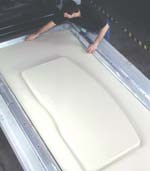Thermoforming Carves New Role in Decorating Wood
Membrane pressing—a process widely used by the lumber industry to decorate shaped wooden cores with a plastic surfacing material—deserves the attention of U.S. thermoformers.
Membrane pressing—a process widely used by the lumber industry to decorate shaped wooden cores with a plastic surfacing material—deserves the attention of U.S. thermoformers. That is the view of Kleerdex Co., which reports rapidly increasing demand for its Kydex heavy-gauge, flame-retardant sheet of acrylic/PVC alloy in this application.
"Membrane pressing opens opportunities for sheet suppliers and thermoformers to transfer their expertise to new markets," says George Southard, a sales representative at Kleerdex, who notes that membrane pressing is analogous in some ways to traditional thermoforming. Southard says demand for Kydex sheet in this process is rising at a double-digit rate for office furniture, hospital furniture, and wall panels, as well as exhibition display systems and other large panels.
How it's done
Membrane pressing uses inflated bladders or membranes to apply uniform pressure to a heated plastic sheet and form it around a CNC-machined wood core, which acts as the mold. Plastic sheet encapsulates the core on three sides (the underside is laminated), making large panels that can incorporate highly rounded contours, waterfall edges, deep undercuts, and holes.
A recent success for membrane pressing of Kydex sheet is the Kiva line of "space-age" office furniture by Herman Miller Co., Zeeland, Mich. The line includes a wing table that doubles as a work station, a mobile storage shell, and moveable office-wall dividers.
The company uses several versions of 0.28-in. sheet in custom colors. Kydex was chosen over thin PVC sheet to increase design freedom and ensure that furniture would survive abuse typical in commercial uses (dent recovery is vital). Kydex offers a notched Izod impact strength of 18 ft-lb/in., inherent flame retardance, high chemical resistance, and excellent appearance.
Membrane pressing for Herman Miller is done by H&R Wood Specialties in Gobles, Mich. Membrane-pressing equipment, which is sold using the Thermolaminator trade name, is supplied by Shaw-Almex USA, which holds patents on the membrane-forming process itself.
Fresh opportunity
Currently, the main market for Kydex acrylic-vinyl sheet is conventional thermoforming. In view of good prospects for growth in solid surfacing, some thermoformers hope to cross-transfer their expertise to membrane pressing, Southard says. One group seeks to use its existing CNC trimming capabilities to machine the wooden cores. Some formers are weighing the purchase of specialized membrane-pressing equipment, while others hope to adapt standard thermoforming equipment to this process.
Southard notes that OEMs in furniture and other end-uses want to design systems utilizing both thermoformed and membrane-pressed parts from a single source. He points to exhibit displays that use thermoformed lighting shrouds and membrane-pressed cabinet doors.
Related Content
-
Novel ‘Clamtainer’ Extends Thermoformer's Reach in Packaging
Uniquely secure latching expands applications for Jamestown Plastics’ patented clamshell package design.
-
Origin Materials Unveils CapFormer for Producing PET Caps
Factory acceptance test completed at commercial scale.
-
Making Gains in the Drain Game
AWD blends extrusion and thermoforming technologies with plenty of home-brewed equipment and processes to keep water away from where it isn’t supposed to be.

















